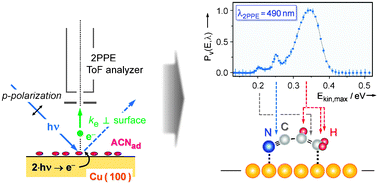Vibrational excitation of adsorbed molecules by photoelectrons of very low energy: acrylonitrile on Cu (100)†
Abstract
In this study, we report on a powerful method of primary photoelectron scattering by adsorbed species. Specifically, threshold-energy (Ekin,max < 0.5 eV) two-![[double bond, length as m-dash]](https://www.rsc.org/images/entities/char_e001.gif) C, C
C, C![[triple bond, length as m-dash]](https://www.rsc.org/images/entities/char_e002.gif) N and C–H stretch modes. From the excitation probability
N and C–H stretch modes. From the excitation probability ![[double bond, length as m-dash]](https://www.rsc.org/images/entities/char_e001.gif) C) = 182(15) meV, Eth(C
C) = 182(15) meV, Eth(C![[triple bond, length as m-dash]](https://www.rsc.org/images/entities/char_e002.gif) N) = 248(16) meV—which are shifted noticeably from the equivalent gas phase values; and Eth(C–H) ∼360–380 meV—which varies only marginally from the gas phase value. The interpretation of the excitation spectra suggests that the di-σ adsorption configuration of the terminal C- and N-atoms dominates, which agrees well with the orientation and bindings predicted in Density Functional Theory (DFT) calculations. Consistent with this is the observation that the contribution to the 2PPE excitation spectra from the C–H stretch motion is by far the largest, which are not directly affected by chemisorption bonding.
N) = 248(16) meV—which are shifted noticeably from the equivalent gas phase values; and Eth(C–H) ∼360–380 meV—which varies only marginally from the gas phase value. The interpretation of the excitation spectra suggests that the di-σ adsorption configuration of the terminal C- and N-atoms dominates, which agrees well with the orientation and bindings predicted in Density Functional Theory (DFT) calculations. Consistent with this is the observation that the contribution to the 2PPE excitation spectra from the C–H stretch motion is by far the largest, which are not directly affected by chemisorption bonding.

- This article is part of the themed collection: Molecular Collision Dynamics

 Please wait while we load your content...
Please wait while we load your content...